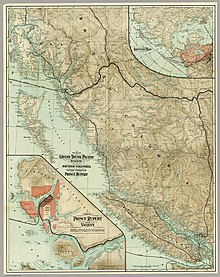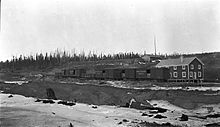Grand Trunk Pacific Railway
standard gauge |
The Grand Trunk Pacific Railway (
Largely constructed 1907–14, the GTPR operated 1914–19, prior to nationalization as the Canadian National Railway (CNR). Despite poor decision-making by the various levels of government and the railway management, the GTPR established local employment opportunities, a telegraph service, and freight, passenger and mail transportation.[1]
Proposal

After the ouster of
Nearer to Asia than
Construction
Overview

During the official ceremony on September 11, 1905 at
The GTPR followed the original Sandford Fleming "Canadian Pacific Survey" route from Jasper, Alberta through the Yellowhead Pass,[14] and the track-laying machine crossed the BC/Alberta border in November 1911.[15] In the mountain region, costs escalated to $105,000 per mile, compared with the budgeted $60,000.[16] Following the CNoR paralleling through the Rockies, which created 108.4 miles (174.5 km) of duplication, the GTPR rail bed largely became redundant.[17][18] The more northerly Pine Pass option, as specified in its charter, may have been a better choice in terms of developing traffic and in improving the current CNR network (especially if the later Pacific Great Eastern Railway route had opted for the Monkman Pass crossing). To secure concessions from the BC government, eastward construction from the Pacific Coast began in 1907.[19] The track east of Prince Rupert reached 50 miles,[20] then 102 miles by 1910,[21] the Bulkley Valley in 1912 and Burns Lake in 1913.[22] The line completed across the prairies, through the Rockies, and to the newly-constructed seaport at Prince Rupert. The last spike ceremony occurred one mile east of Fort Fraser, British Columbia at Stuart (Finmoore) on April 7, 1914.[23][24] A 1910 prediction had correctly claimed if a line were built from Tête Jaune Cache to Vancouver, it would effectively kill Prince Rupert and relegate its route to branch line status.[25]
Construction crews
Claiming labour shortages, the GTP attempted to obtain government approval to bring in unskilled immigrants from Asia.[26] By late 1912, 6,000 men had become employed east of Edmonton.[27] Although contractors prohibited liquor in camps, bootlegging was rampant.[28] FW&S provided hospitals and medical services by charging employees one dollar per month.[29] The articles for the Grand Canyon of the Fraser, Dome Creek, McGregor, Upper Fraser, and the BC communities within the Category:Grand Trunk Pacific Railway stations, outline construction through those specific localities.
Flat-bottomed sternwheelers
FW&S operated five steamboats to supply their camps advancing east from Prince Rupert on the Skeena River. Launched in 1908, the Distributor and Skeena remained until 1914, as did the Omineca, which was purchased in 1908. Launched in 1909, the Operator and Conveyor were disassembled in 1911, transported to Tête Jaune and relaunched in 1912 on the Fraser River.[30][31][32] Detailed articles cover the sternwheelers Skeena, Operator, and Conveyor and their roles on the Skeena River, and on the Fraser River.
Fraser River scows
During the construction phase from Tête Jaune to Fort George thousands of tons of freight for railway construction and merchants travelled downstream from the railhead by scow.[33][34] In 1913, when scowing on that part of the river peaked, about 1,500 men were employed as scowmen, or "River Hogs," as they were generally called. In high water, the trip from Tête Jaune took five days and in low water up to 12 days because of the shallow bars. Each vessel measured about 40 feet long and 12–16 feet wide and carried 20–30 tons. Two men crewed each end. The Goat River Rapids, Grand Canyon, and Giscome Rapids, were extremely dangerous, with wrecks and drownings common. Dismantlers purchased the scows that survived the journey, selling the used lumber primarily for house building.[35]
Real estate development
The funding for railway expansion depended upon returns from the sale of land acquired by the railway. The Grand Trunk Pacific Town & Development Co. was responsible for locating and promoting strategic town sites.[36] However, the priority of maximizing profit undermined the economic prosperity of communities and other businesses by hampering the increase in traffic volumes essential for the GTP’s own survival.[37] In 1910 at Prince Rupert, although 25 real estate agents operated, David Hayes, the brother of GTP President Charles Melville Hays, was the sole company agent.[38]
In what would become Prince George, the company purchased the First Nations reserve for a railway yard and a new town site.[39] The GTPR also caused the displacement and the socio-economic destruction of native communities along the route, many of which had social and economic values in conflict with those of the railway.[40]
Steamships
Beginning in 1910, a GTPR steamship service operated from Prince Rupert. The first ship, the SS Prince Albert (formerly the Bruno built in 1892 at Hull, England), was an 84-ton, steel-hulled vessel and travelled as far as Vancouver and Victoria. Next, the SS Prince John (formerly the Amethyst built in England in 1910), travelled to the Queen Charlotte Islands. Built in 1910, the much larger SS Prince George and SS Prince Rupert, both 3,380-ton, 18-knot vessels, could carry 1,500 passengers with staterooms for 220. The ships operated a weekly service from Seattle to Victoria, Vancouver, Prince Rupert and Anyox.[41]
The vision was for coastal shipping to mature into a trans-Pacific line.[42] However, Prime Minister Robert Borden was uninterested in promoting Prince Rupert as a port of call for any shipping lines. Vancouver flourished, but Prince Rupert languished.[43] From 1919, the Canadian Government Merchant Marine (CGMM),[44] in partnership with CNR, promoted the development of import/export trade with Pacific rim countries. Although the expansion benefitted Vancouver,[45] Prince Rupert remained a backwater.
Ancillary facilities

The GTPR built the Fort Garry Hotel in Winnipeg and the Hotel Macdonald in Edmonton. Halibird and Roche of Chicago designed the hotel for Prince George, but it never left the drawing-board stage. Construction of the $2m Chateau Prince Rupert, designed by Francis Rattenbury, did not proceed beyond the foundations, laid in 1910. Its forerunner, the temporary GTP Inn, was demolished in 1962. Sometimes in conjunction with the CNoR, the GTPR built some impressive city stations.[46][47][48][49]
When built in 1910, the Grand Trunk Pacific dock in Seattle was the largest on the West Coast. On July 30, 1914, fire destroyed the facility. The federal government provided a $2m subsidy for a dry dock at Prince Rupert to handle ships up to 20,000 tons. Completed in 1915, it catered for only much smaller local vessels prior to World War II. It was dismantled in 1954 to 1955.[50][51][52]
Operations

The CNoR tracklaying through the Canadian Rockies in 1913 roughly paralleled the GTPR line of 1911 and created about 100 miles of duplication. In 1917, a contingent from the Corps of Canadian Railway Troops added several crossovers to amalgamate the tracks into a single line along the preferred grade from Lobstick, Alberta, to Red Pass Junction, British Columbia. The surplus rails were lifted and the heavier-grade GTPR ones shipped to France for use during World War I.
Through the 1910s, several branches were built by the GTP under the Grand Trunk Pacific Branch Lines Company and the Grand Trunk Pacific Saskatchewan Railway Company, subsidiaries of GTP. These included branches to Prince Albert, Battleford, Calgary, and to the international border via Regina.[53] Further branches were projected, and many were completed under Canadian National.
In 1915, unable to meet its debts, the GTP asked the federal government to take over the GTPR.
Current status
Today, the majority of the GTPR is still in use as CN's (name change to Canadian National or acronym "CN" in 1960) main line from Winnipeg to Jasper. The former CNoR line, and a later connection to
After a century languishing far behind Vancouver, the
See also
- Jasper–Prince Rupert passenger service
- List of Grand Trunk Pacific Railway stations
- History of rail transport in Canada
- List of defunct Canadian railways
Footnotes
- ^ Morrow 2010, pp. 107–108.
- ^ MacKay 1986, pp. 40, 45 & 47.
- ^ Morrow 2010, p. 13.
- ^ Morrow 2010, p. 9.
- ^ MacKay 1986, p. 64.
- ^ MacKay 1986, pp. 63 & 66.
- ^ MacKay 1986, p. 8.
- ^ Morrow 2010, pp. 13–15.
- ISBN 1-55289-900-4
- ^ MacKay 1986, pp. 86 & 87.
- ^ a b MacKay 1986, p. 71.
- ^ MacKay 1986, p. 76.
- ^ Morrow 2010, p. 23.
- ^ a b Morrow 2010, p. 14.
- ^ Fort George Herald, 23 Dec 1911
- ^ MacKay 1986, pp. 101–102.
- ^ Lower 1939, p. 195.
- ^ "Map of duplicate track lifted 1917" (PDF). www.railwaystationlists.co.uk.
- ^ Morrow 2010, pp. 16 & 23.
- ^ Fort George Tribune, 6 Aug 1910
- ^ Fort George Tribune, 31 Dec 1910
- ^ MacKay 1986, p. 103.
- ^ Morrow 2010, p. 24.
- ^ MacKay 1986, p. 104.
- ^ Fort George Herald, 17 Sep 1910
- ^ Fort George Tribune, 25 Dec 1909
- ^ Fort George Tribune, 16 Nov 1912
- ^ Wheeler 1979, p. 121.
- ^ Morrow 2010, p. 45.
- ^ Fort George Herald, 6 Jan 1912
- ^ Wheeler 1979, p. 107.
- ^ Morrow 2010, p. 37.
- ^ "Scow Boats, Heavy Haulers on the Athabasca River, Alberta, Canada". fhnas.ca. 30 June 2017.
- ^ Morrow 2010, p. 40.
- ^ Prince George Citizen, 26 May 1938
- ^ Morrow 2010, pp. 26–28.
- ISBN 9780774805322.
- ^ MacKay 1986, pp. 98–99.
- ^ Morrow 2010, p. 26.
- ^ McDonald, James A (1990). "Bleeding Day and Night: The Construction of the Grand Trunk Pacific Railway Across Tsimshian Reserve Lands" (PDF). www3.brandonu.ca. Canadian Journal of Native Studies.
- ^ "Old Time Trains". www.trainweb.org.
- ^ MacKay 1986, p. 99–100.
- ^ MacKay 1986, pp. 118–119.
- ^ "CGMM 1919–28". www.theshipslist.com.
- ^ MacKay 1986, pp. 122–127.
- ^ a b MacKay 1986, p. 105.
- ISBN 9781411685185.
- ^ Lower 1939, p. 127.
- ^ Prince George Citizen, 6 Mar 1985 (41)
- ^ "Prince Rupert Dry Dock". www.shipbuildinghistory.com.
- ^ "Living Landscapes". royalbcmuseum.bc.ca. Archived from the original on 2018-08-16. Retrieved 2018-08-15.
- ^ MacKay 1986, p. 99.
- ^ Horky, David W. "Guide To The Grand Trunk Pacific Railway Cartographic Series" (PDF). National Arcives of Canada. Retrieved December 13, 2022.
- ^ Morrow 2010, pp. 98–101.
- ^ Prince George Citizen, 20 Sep 2001
- ^ MacKay 1986, p. 120.
- ^ Prince George Citizen, 12 Mar 1919
- ^ Lower 1939, p. 183.
- ^ MacKay 1986, p. 121.
- ^ a b MacKay 1986, pp. 74 & 102.
- ^ Morrow 2010, pp. 98, 102–103.
- ^ Morrow 2010, pp. 76–80.
- ^ "Port of Prince Rupert Employment Surges, 31 Jul 2019". www.businessexaminer.ca. 31 July 2019.
- ^ "Prince Rupert port receives $153.7m federal funding injection, 6 Sep 2019". www.nsnews.com. Archived from the original on 10 October 2019. Retrieved 10 October 2019.
References
- Leonard, Frank. A Thousand Blunders: The Grand Trunk Pacific Railway and Northern British Columbia. Vancouver: University of British Columbia Press, 1996.
- Lower, Joseph Arthur (1939). The Grand Trunk Pacific Railway and British Columbia. www.library.ubc.ca (Thesis). .
- MacKay, Donald (1986). The Asian Dream: The Pacific Rim and Canada's National Railway. Douglas & McIntyre. ISBN 0-88894-501-9.
- Morrow, Trelle A. (2010). The Grand Trunk Pacific and other Fort George stuff. CNC Press. ISBN 9780921087502.
- Wheeler, Marilyn J. (1979). The Robson Valley Story. McBride Robson Valley Story Group. ISBN 0969020902.
- "Prince George archival newspapers". www.pgpl.ca.
- Todd, John (September 1976). "The Grand Trunk Pacific's Lake Superior Branch" (PDF). Canadian Rail. 296. Canadian Railroad Historical Association. ISSN 0008-4875. Archived from the original(PDF) on 2020-05-03. Retrieved 2020-01-26.
